Archive
20th Century German Art
- 20th Century German Art
Word Count: 4
- Exhibition
- 07-07-1938
- 27-08-1938
The 20th Century German Art exhibition of 1938 gave visibility to artists who had been defamed at the Munich exhibition Entartete Kunst and were persecuted by the National Socialist regime.
Word Count: 29
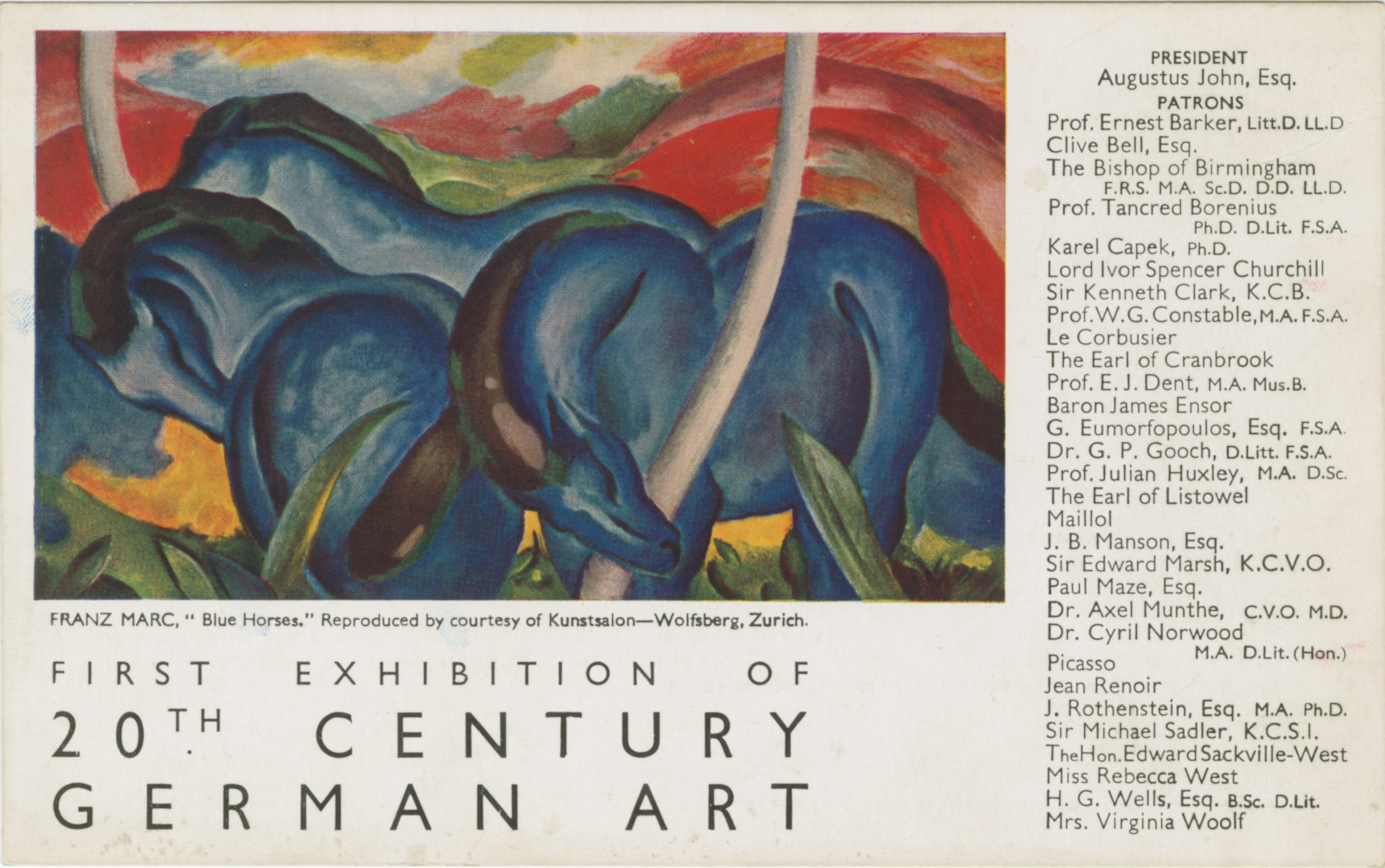
Invitation card to the 20th Century German Art exhibition, 1938, front cover with Franz Marc’s painting Blue Horses from 1911 (Akademie der Künste, Berlin, Heinz-Worner-Archiv 174). 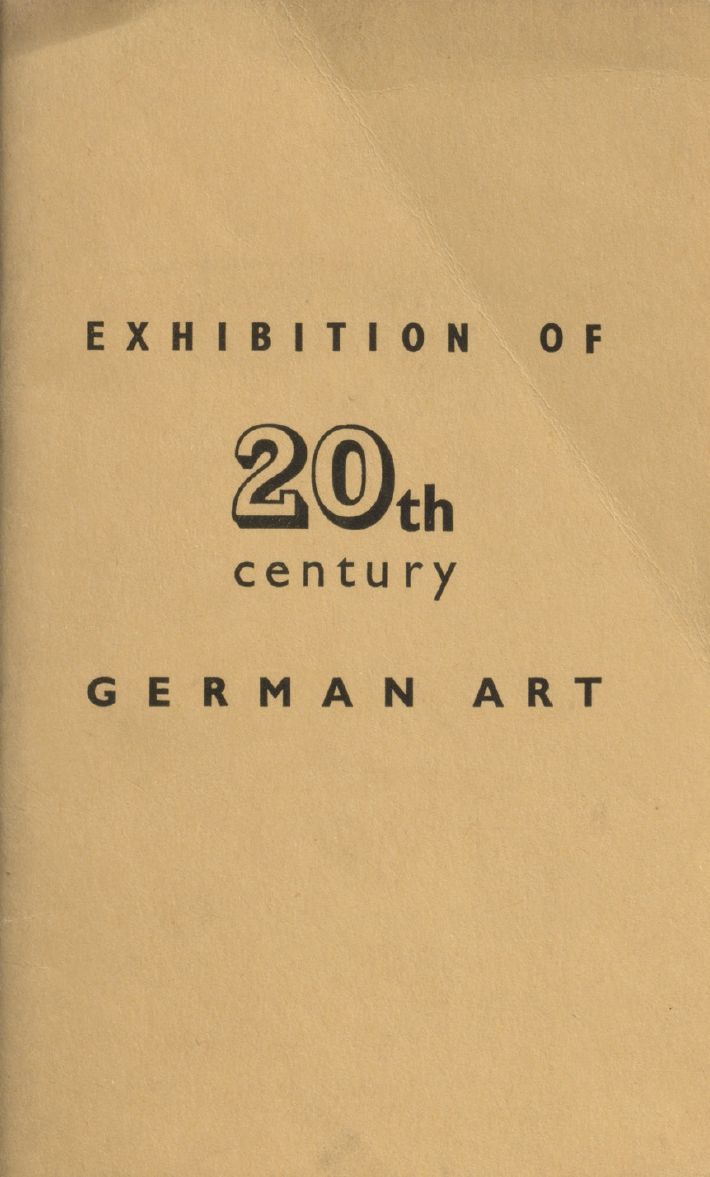
20th Century German Art exhibition catalogue, 1938, cover (Rare Books and Special Collections, McGill University). 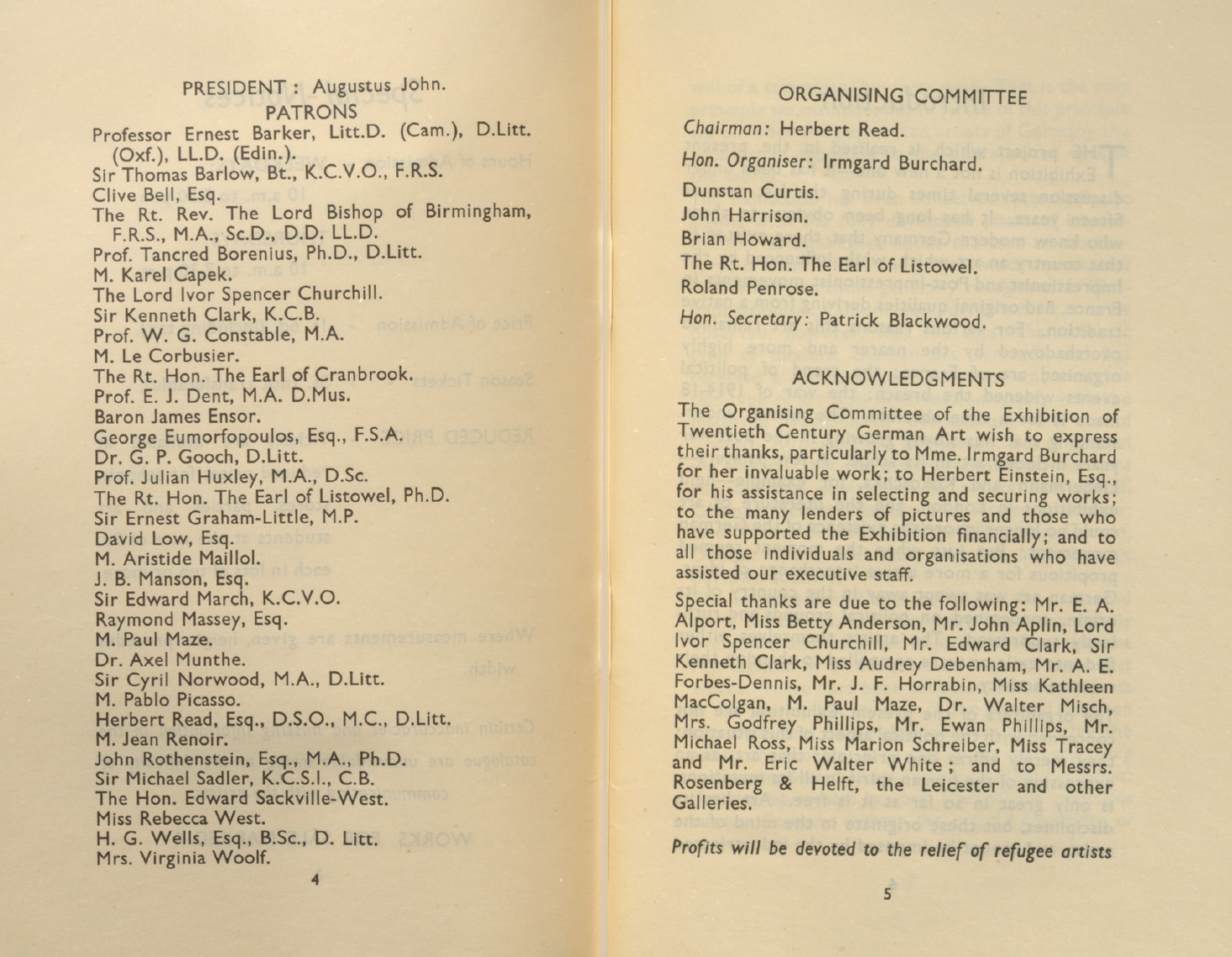
20th Century German Art exhibition catalogue, 1938, pp. 4–5 (Rare Books and Special Collections, McGill University). 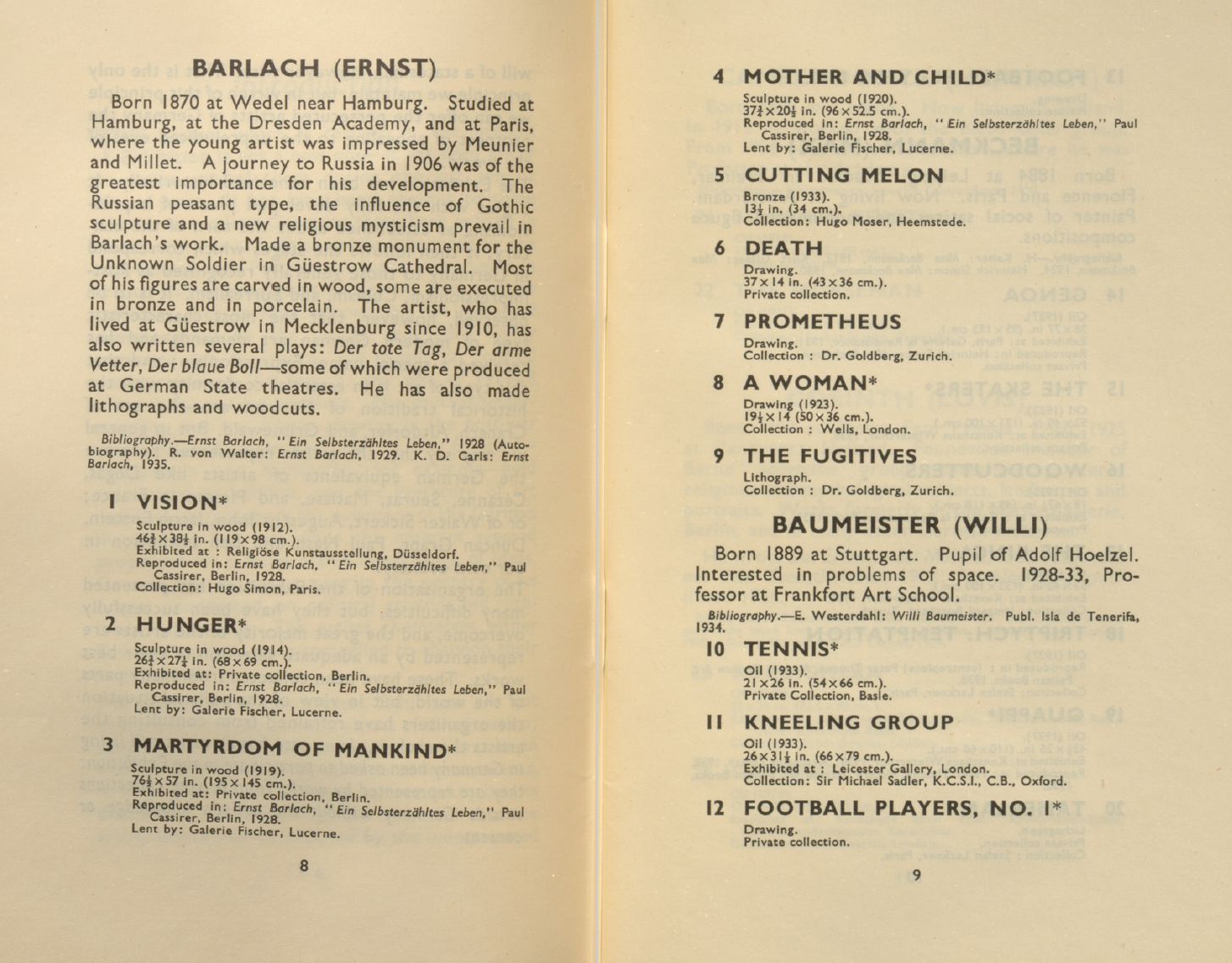
20th Century German Art exhibition catalogue, 1938, pp. 8–9: Ernst Barlach’s Hunger (no. 2) was purchased by the to the Friends of the Whitworth Fund and presented to the Whitworth Gallery in Manchester (Rare Books and Special Collections, McGill University). 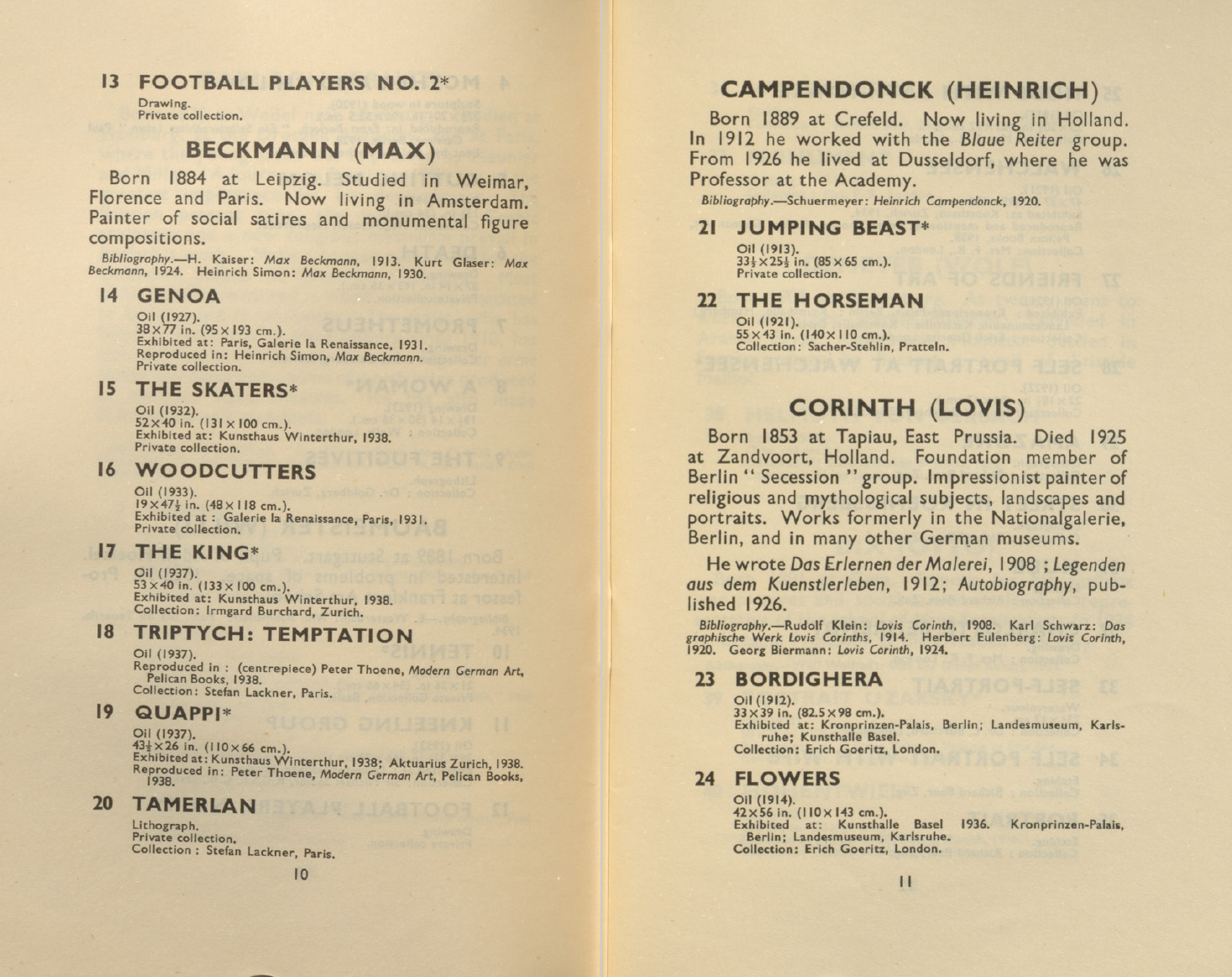
20th Century German Art exhibition catalogue, 1938, pp. 10–11: Max Beckmann’s Triptych: Temptation (no. 18) was one of the signature works of the exhibition (Rare Books and Special Collections, McGill University). 
20th Century German Art exhibition catalogue, 1938, pp. 14–15: Benno Elkan’s Head of Alfred Flechtheim (1911) from the possession of the artist (Rare Books and Special Collections, McGill University). 
20th Century German Art exhibition catalogue, 1938, p. 47: Erna Auerbach, Martin Bloch, Georg Ehrlich and other artists are mentioned in a separate section of the catalogue titled “Artists now working in England” (Rare Books and Special Collections, McGill University). 
20th Century German Art exhibition catalogue, 1938, pp. 48–49: Hans Feibusch, Paul Hamann, Hein Heckroth, Tiza Hess, Walter Hoefner and other artists are mentioned in a separate section of the catalogue titled “Artists now working in England” (Rare Books and Special Collections, McGill University). 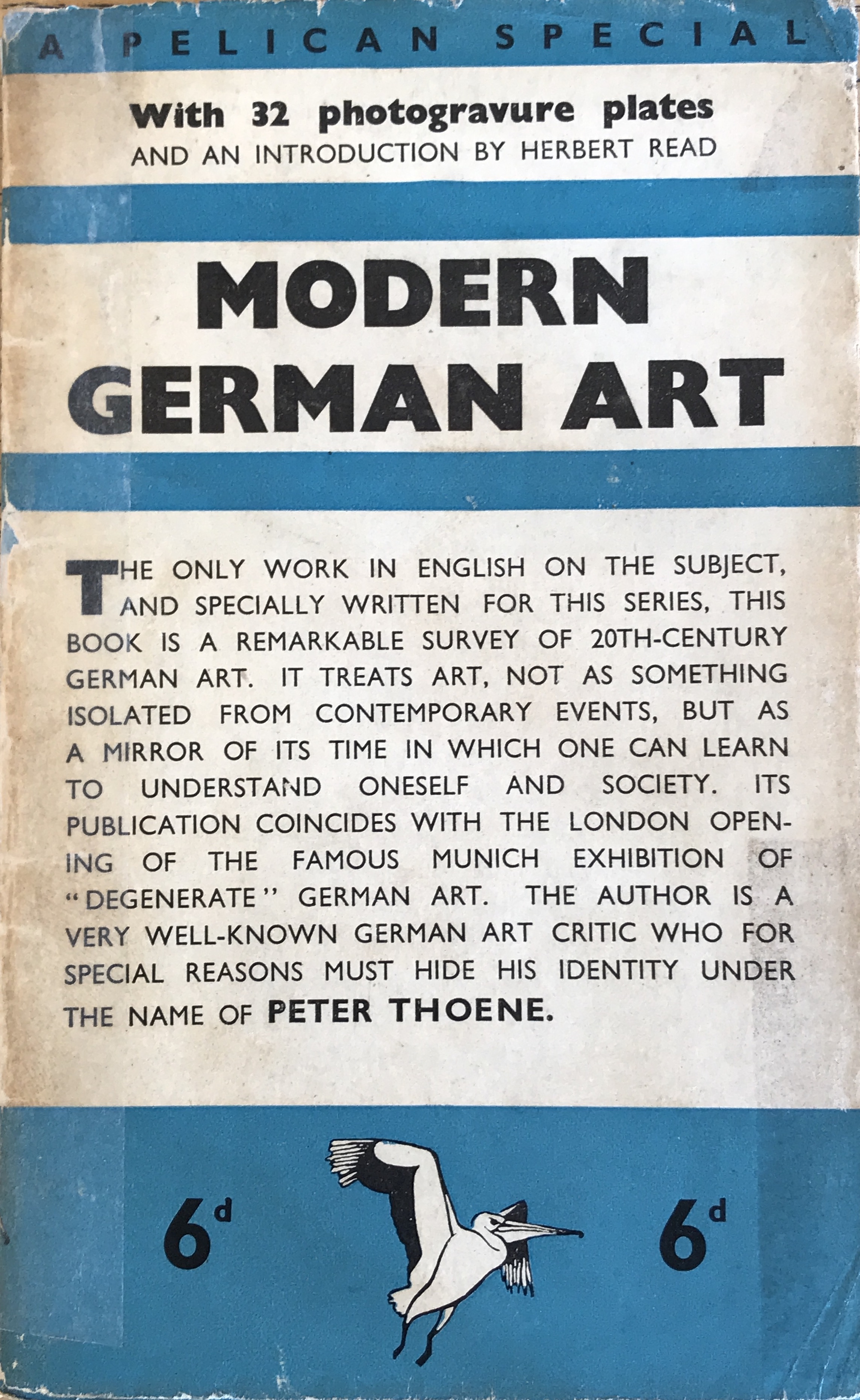
Peter Thoene [Oto Bihalji-Merin]. Modern German Art. Penguin Books, 1938, cover (Universität Hamburg, Walter A. Berendsohn Forschungsstelle für deutsche Exilliteratur). 
Information on Peter Thoene [Oto Bihalji-Merin] in the book Modern German Art, 1938 (Universität Hamburg, Walter A. Berendsohn Forschungsstelle für deutsche Exilliteratur). 
Reproduction of Franz Marc’s Blue Horses in Peter Thoene’s Modern German Art, 1938 (Universität Hamburg, Walter A. Berendsohn Forschungsstelle für deutsche Exilliteratur). 
N. “Twentieth-Century German Art.” The Manchester Guardian, 7 July 1938, p. 7 (Photo: Private Archive). 
Article “Whitworth Acquisitions” in The Manchester Guardian, 29 July 1938, p. 13 mentioning acquisitions from the 20th Century German Art exhibition by the Whitworth Gallery in Manchester. 
Announcement for the exhibition in The Observer, 14 August 1938, p. 2 (Photo: Private Archive). Dogramaci, Burcu. “Aufs richtige Pferd gesetzt! Zur frühen Geschichtsschreibung des Expressionismus.” Fritz Burger (1877–1916) – ‘eine neue Kunstgeschichte’ (Veröffentlichungen des Zentralinstituts für Kunstgeschichte in München, 43), edited by Ulrich Pfisterer, Dietmar Klinger Verlag, 2016, pp. 189–208.
Elliott, David. “Modern German Art 1938: The Book.” London 1938. Defending ‘degenerate’ Art. Mit Kandinsky, Liebermann und Nolde gegen Hitler, edited by Lucy Wasensteiner and Martin Faass, exh. cat. The Wiener Library for the Study of the Holocaust & Genocide, London, 2018a, pp. 152–160.
Exhibition of 20th Century German Art, exh. cat. New Burlington Galleries, London, 1938.
Exhibition of German-Jewish Artists’ Work: Painting – Sculpture – Architecture, exh. cat. Parsons Galleries, London, 1934.
Flechtheim, Alfred. “Postscript.” James Laver. French Painting And The Nineteenth Century. B.T. Batsford Ltd., 1937, pp. 101–114.
Frowein, Cordula. “Ausstellungsaktivitäten der Exilkünstler.” Kunst im Exil in Großbritannien 1933–1945, exh. cat. Neue Gesellschaft für bildende Kunst, Berlin, 1986, pp. 35–48.
Hedley, Gill. “Three female gallerists who changed the course of British art.” 29 September 2016, Royal Academy of Arts, www.royalacademy.org.uk/article/movers-and-shakers-female-gallerists-british-art. Accessed 27 January 2021.
Holz, Keith. “The United States tour of 20th Century (Banned) German Art.” London 1938. Defending ‘degenerate’ Art. Mit Kandinsky, Liebermann und Nolde gegen Hitler, edited by Lucy Wasensteiner and Martin Faass, exh. cat. The Wiener Library for the Study of the Holocaust & Genocide, London, 2018a, pp. 215–223.
Lackner, Stephan, and Helen Adkins. “Exhibition of the 20th Century German Art.” Stationen der Moderne. Die bedeutenden Kunstausstellungen des 20. Jahrhunderts in Deutschland, edited by Eberhard Roters, exh. cat. Berlinische Galerie, Martin-Gropius-Bau, Berlin, 1988, pp. 315–337.
London 1938. Defending ‘degenerate’ Art. Mit Kandinsky, Liebermann und Nolde gegen Hitler, edited by Lucy Wasensteiner and Martin Faass, exh. cat. The Wiener Library for the Study of the Holocaust & Genocide, London, 2018.
Mortimer, Raymond. “German Artists.” The New Statesman and Nation, vol. 16, no. 286, 16 July 1938, pp. 112–113.
N. “Twentieth-century German Art.” The Manchester Guardian, 7 July 1938, p. 7.
Raddatz, Fritz J. “Ein glückliches Leben in der Hölle. Ein Gespräch mit Oto Bihalji-Merin.” Die Zeit, no. 22, 27 May 1988, pp. 37–39.
Staff Correspondents. “Whitworth Acquisitions.” The Manchester Guardian, 29 July 1938, p. 13.
Summers, Cherith. “Exhibition of German-Jewish Artists’ Work: Painting – Sculpture – Architecture.” Brave New Visions. The Émigrés who transformed the British Art World, exh. cat. Sotheby’s, St. George’s Gallery, London, 2019, p. 14. issuu, https://issuu.com/bravenewvisions/docs/brave_new_visions. Accessed 25 February 2021.
Thoene, Peter [Oto Bihalji-Merin]. Modern German art. Translated by Charles Fullman, Penguin Books, 1938.
First Exhibition of 20th Century German Art, invitation card (Akademie der Künste, Berlin, Archiv Bildende Kunst, Heinz-Worner-Archiv, July 1938), 174.
Wasensteiner, Lucy. “A British Statement against Nazi Policy? The Organisation of Twentieth Century German Art.” London 1938. Defending ‘degenerate’ Art. Mit Kandinsky, Liebermann und Nolde gegen Hitler, edited by Lucy Wasensteiner and Martin Faass, exh. cat. The Wiener Library for the Study of the Holocaust & Genocide, London, 2018a, pp. 59–66.
Wasensteiner, Lucy. “The Public Response to 20th Century German Art.” London 1938. Defending ‘degenerate’ Art. Mit Kandinsky, Liebermann und Nolde gegen Hitler, edited by Lucy Wasensteiner and Martin Faass, exh. cat. The Wiener Library for the Study of the Holocaust & Genocide, London, 2018b, pp. 183–188.
Wasensteiner, Lucy. The Twentieth Century German Art Exhibition. Answering Degenerate Art in 1930s London. Routledge, 2019. Taylor & Francis, doi: https://doi.org/10.4324/9781351004145. Accessed 7 April 2021.
Word Count: 521
Akademie der Künste, Berlin, Archiv Bildende Kunst, Heinz-Worner-Archiv.
Word Count: 9
My deepest thanks go to Jennifer Garland at Rare Books and Special Collections, McGill University, who provided me with a scan of the 20th Century German Art exhibition catalogue.
Word Count: 29
New Burlington Galleries, 5 Burlington Gardens, Mayfair, London W1.
- London
- Burcu Dogramaci. "20th Century German Art." METROMOD Archive, 2021, https://archive.metromod.net/viewer.p/69/1470/object/5141-11260411, last modified: 26-04-2021.
-
Kurt SchwittersArtistPoetLondon
The artist and poet Kurt Schwitters lived in London between 1941 and 1945, where he stood in contact to émigré and local artists, before moving to the Lake District.
Word Count: 27
Herbert ReadArt HistorianArt CriticPoetLondonThe British art historian Herbert Read established himself as a central figure in the London artistic scene in the 1930s and was one of the outstanding supporters of exiled artists.
Word Count: 30
Exhibition of German Jewish Artists’ Work: Painting – Sculpture – ArchitectureExhibitionLondonThe Exhibition of German Jewish Artists’ Work was organised in 1934 by Carl Braunschweig at the Parsons Galleries in Oxford Street and featured 220 works by German Jewish artists.
Word Count: 27
Lindsay DrummondPublishing HouseLondonThe artist John Heartfield designed covers for the publishing house Lindsay Drummond, which had an anti-fascist programme and published books by emigrated authors such as Wilhelm Necker and Felix Langer.
Word Count: 30
Roland, Browse & DelbancoGalleryArt DealerLondonÉmigré art historians and art dealers, Henry Roland and Gustav Delbanco, along with Lillian Browse, opened their Mayfair gallery, Roland, Browse & Delbanco, in 1945.
Word Count: 24
Marlborough Fine ArtArt GalleryLondonMarlborough Fine Art was founded in 1946 by the Viennese emigrants Harry Fischer and Frank Lloyd in the Mayfair district, focused on Impressionists, Modern and Contemporary Art.
Word Count: 26
Thames & HudsonPublishing HouseLondonThe emigrants Eva Feuchtwang (later Eva Neurath) and Walter Neurath founded the Thames & Hudson publishing house in 1949, which published art history books, photo books and collection catalogues.
Word Count: 28
Faber & FaberPublishing HouseLondonFaber & Faber shows the importance of publishing houses as supporters of contemporary art movements and of the contribution of emigrants, helping to popularise their art and artistic theories.
Word Count: 29
Gerty SimonPhotographerLondonThe Berlin photographer Gerty Simon established a studio in Chelsea, London. Her solo exhibition Camera Portraits from 1935 featured a distinctive portrait of the émigré art dealer Alfred Flechtheim (shown above).
Word Count: 30
Julian HuxleyZoologistPhilosopherWriterLondonJulian Huxley was the director of London Zoo from 1935 to 1942 and worked closely with emigrant photographers, artists and architects, including Berthold Lubetkin, Erna Pinner and Wolf Suschitzky.
Word Count: 27
Ludwig Meidner, Drawings 1920–1922 and 1935–49, Else Meidner, Paintings and Drawings 1935–1949ExhibitionLondonIn 1949, a joint exhibition of works by Ludwig and Else Meidner opened at the Ben Uri Art Gallery. It was the first solo exhibition of the artists in London.
Word Count: 29